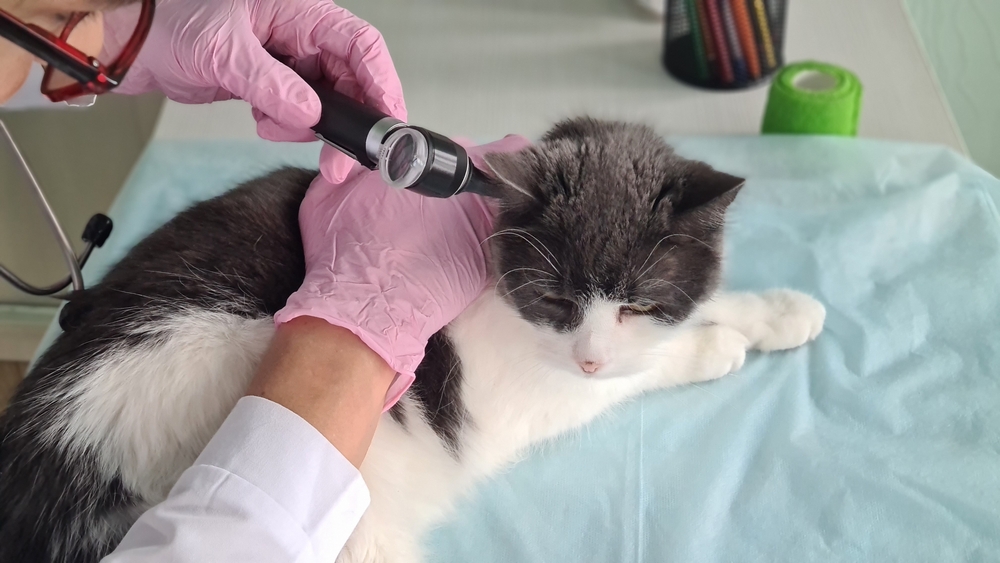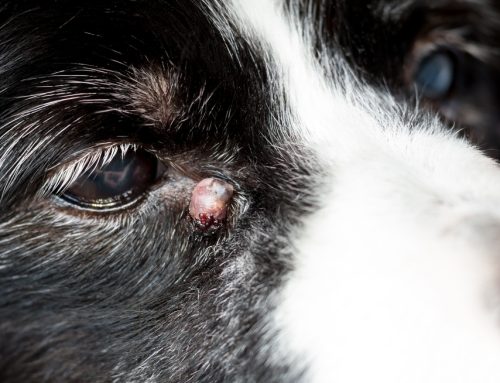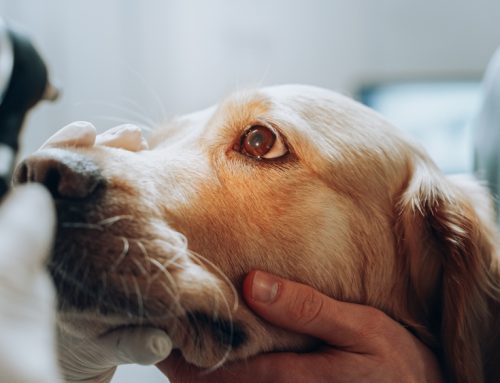Ear infections are common in pets, and when the middle ear is affected, the infection can lead to complications beyond the ear. In some cases, otitis media (i.e., middle ear inflammation) causes ocular conditions. Our Veterinary Vision Center team treats all manner of pet eye conditions, and we provide information about ocular conditions associated with otitis media.
Understanding pet otitis media
The middle ear lies inside the temporal bone and extends from the eardrum to the inner ear wall. The middle ear transmits vibrations from the eardrum to the inner ear via auditory ossicles or bones—malleus, incus, and stapes. Otitis media is inflammation of the middle ear, and in dogs, typically results secondary to chronic otitis externa (i.e., inflammation of the outer ear) that invades the eardrum. The condition can also be caused by a foreign body, eardrum rupture during ear cleaning, and primary secretory otitis media (PSOM) in Cavalier King Charles spaniels. In cats, otitis media is most often caused by viral infections that travel from the respiratory tract through the eustachian tube. Other causes in felines include nasal polyps, chronic ear mite infestations, and chronic otitis externa.
Common signs include head shaking, pawing at the affected ear, and redness, discharge, and odor from the ear. Left untreated, otitis media can lead to otitis interna (i.e., inflammation of the inner ear), and damage the hearing apparatus, potentially causing hearing loss and neurological signs.
Horner’s syndrome associated with otitis media in pets
Two important nerves, the facial and sympathetic nerves, travel through the middle ear and are responsible for innervating the face and eye. Otitis media can affect these nerves, resulting in a condition known as Horner’s syndrome. Signs include a constricted pupil, elevated third eyelid, eye globe retraction, which may make the eye appear smaller than the other eye, and upper eyelid drooping.
Treatment involves resolving the otitis media, but a topical medication called phenylephrine can minimize signs until the otitis media is resolved. Recovery depends on the extent of nerve damage and may take several weeks. Fortunately, Horner’s syndrome is not painful and doesn’t affect the pet’s eyesight.
Keratoconjunctivitis sicca associated with otitis media in pets
Keratoconjunctivitis sicca (KCS) or dry eye is caused by inadequate tear production and leads to corneal drying and inflammation. Tears are necessary to lubricate the cornea and surrounding tissues and remove debris or pathogens that enter the eye. Any condition that inhibits tear film production can cause dry eye.
The facial nerve is responsible for innervating the lacrimal (i.e., tear) gland, and if this nerve is damaged by otitis media, neurogenic keratoconjunctivitis sicca (nKCS) can result. NKCS can also be caused by certain long-acting medications used to treat ear infections. KCS signs include painful, red, irritated eyes, excessive blinking, holding the eye closed, and a thick, mucoid ocular discharge. Corneal ulceration and corneal scarring, which appear as a dark brown film covering the eye, can develop.
Our Veterinary Vision Center team diagnoses KCS using a Schirmer tear test, which involves placing a special wicking paper in your pet’s eye and measuring tear production for one minute. We will also perform other tests, such as corneal staining. KCS treatment typically involves medications to decrease inflammation and promote tear production, but with nKCS, the glands can’t produce more tears until the nerve heals, so the underlying otitis media must be cleared before nKCS can resolve. Topical medications are used to keep the cornea lubricated and decrease inflammation and discomfort until tear production returns. Properly treated, nKCS typically resolves after a few months, although some pets require life-long medication.
If your pet has an ocular condition associated with an ear infection, contact our Veterinary Vision Center team. We will work with your primary veterinarian to develop an effective treatment plan.







Leave A Comment